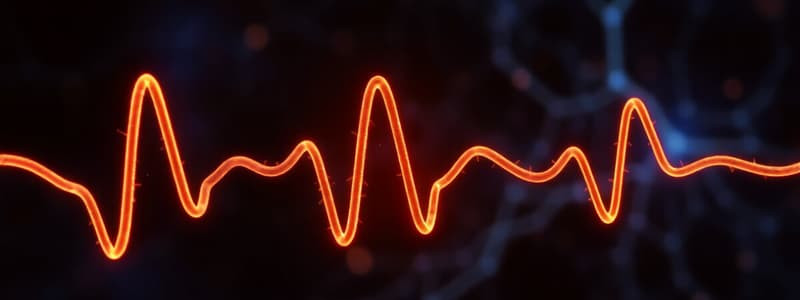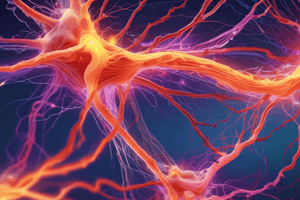Podcast
Questions and Answers
What is the resting membrane potential of a cardiac myocyte during the quiescent period?
What is the resting membrane potential of a cardiac myocyte during the quiescent period?
- +30 mV
- 0 mV
- -70 mV
- -90 mV (correct)
Which ion channels primarily mediate the transient outward potassium current (Ito)?
Which ion channels primarily mediate the transient outward potassium current (Ito)?
- Calcium channels
- Chloride channels
- Sodium channels
- Potassium channels (correct)
What is the primary function of the Na+/Ca2+ exchanger (INCX) in cardiac myocytes?
What is the primary function of the Na+/Ca2+ exchanger (INCX) in cardiac myocytes?
- To pump sodium into the cell
- To maintain a stable resting membrane potential
- To pump calcium into the cells in exchange for sodium (correct)
- To conduct potassium out of the cell
During which phase do potassium ions leave the cell, leading to a more negative membrane potential?
During which phase do potassium ions leave the cell, leading to a more negative membrane potential?
What characteristic of the inward rectifying potassium channel (Kir) allows it to function effectively at low voltages?
What characteristic of the inward rectifying potassium channel (Kir) allows it to function effectively at low voltages?
What is the resting membrane potential of slow-response cells?
What is the resting membrane potential of slow-response cells?
What is the net effect of the ionic events mediated by Ik1 current in cardiac myocytes?
What is the net effect of the ionic events mediated by Ik1 current in cardiac myocytes?
Which phase of the cardiac action potential demonstrates a more significant amplitude in fast-response cells compared to slow-response cells?
Which phase of the cardiac action potential demonstrates a more significant amplitude in fast-response cells compared to slow-response cells?
What is the significance of the quiescent period for the cardiac myocyte?
What is the significance of the quiescent period for the cardiac myocyte?
What is the threshold potential for spontaneous action potential generation in cardiac pacemaker cells?
What is the threshold potential for spontaneous action potential generation in cardiac pacemaker cells?
What voltage range do inward rectifying potassium channels (Kir) become largely impermeable to potassium ions?
What voltage range do inward rectifying potassium channels (Kir) become largely impermeable to potassium ions?
How does the conduction of action potentials differ between slow-response and fast-response cardiac tissue?
How does the conduction of action potentials differ between slow-response and fast-response cardiac tissue?
What is the impact of Na+ and Ca2+ ions in the depolarization process of cardiac cells?
What is the impact of Na+ and Ca2+ ions in the depolarization process of cardiac cells?
What triggers the rapid depolarization in Phase 0 of the cardiac action potential?
What triggers the rapid depolarization in Phase 0 of the cardiac action potential?
Which phase of the cardiac action potential is characterized by the transient opening of K currents?
Which phase of the cardiac action potential is characterized by the transient opening of K currents?
What happens to the membrane potential during Phase 0 of the cardiac action potential?
What happens to the membrane potential during Phase 0 of the cardiac action potential?
What is the primary ionic event involved in Phase 2 of the cardiac action potential?
What is the primary ionic event involved in Phase 2 of the cardiac action potential?
Which statement accurately describes the end of Phase 1?
Which statement accurately describes the end of Phase 1?
What characterizes Phase 4 of the cardiac action potential?
What characterizes Phase 4 of the cardiac action potential?
During which phase do K+ channels open, allowing repolarization to occur?
During which phase do K+ channels open, allowing repolarization to occur?
What happens during Phase 1 of the cardiac action potential?
What happens during Phase 1 of the cardiac action potential?
What characterizes phase 4 of the action potential in autorhythmic cells?
What characterizes phase 4 of the action potential in autorhythmic cells?
In which part of the cardiac muscle are autorhythmic cells primarily found?
In which part of the cardiac muscle are autorhythmic cells primarily found?
How do the durations of contraction and action potential compare in cardiac myocytes?
How do the durations of contraction and action potential compare in cardiac myocytes?
What is the primary function of the sinoatrial node in the heart?
What is the primary function of the sinoatrial node in the heart?
What happens when phase 4 reaches threshold in the action potential of the sinoatrial node?
What happens when phase 4 reaches threshold in the action potential of the sinoatrial node?
What is the duration of phase 4 in the action potential of cardiac autorhythmic cells?
What is the duration of phase 4 in the action potential of cardiac autorhythmic cells?
What primarily causes the slow depolarization observed in phase 4?
What primarily causes the slow depolarization observed in phase 4?
Which of the following correctly describes the role of Purkinje fibers in the heart?
Which of the following correctly describes the role of Purkinje fibers in the heart?
What is the primary function of Lead I in an ECG?
What is the primary function of Lead I in an ECG?
Which leads define the anterior wall of the heart in a standard ECG?
Which leads define the anterior wall of the heart in a standard ECG?
Which ECG lead configuration is bipolar?
Which ECG lead configuration is bipolar?
What position should a patient be in when recording an ECG?
What position should a patient be in when recording an ECG?
How many precordial leads are used in a standard ECG setup?
How many precordial leads are used in a standard ECG setup?
What type of leads are aVR, aVL, and aVF considered?
What type of leads are aVR, aVL, and aVF considered?
Which leads represent the right side of the heart in an ECG?
Which leads represent the right side of the heart in an ECG?
What does the lead configuration V1 and V2 primarily assess in the heart?
What does the lead configuration V1 and V2 primarily assess in the heart?
Study Notes
Cardiac Action Potential Phases
- Action potential (AP) may drop to approximately +30 mV before returning to resting potential.
- Duration of each phase varies and is not clearly defined.
- Potassium channels open, allowing transient outward potassium current (Ito) which transitions membrane potential from positive to negative.
Phase 4: Resting Potential
- Cardiac myocyte remains quiescent with a resting membrane potential around -90 mV, ready for depolarization.
- Na+/Ca2+ exchanger (INCX) facilitates calcium influx in exchange for sodium efflux, driven by antiporter protein.
- Inward rectifying potassium current (Ik1) contributes to more negative intracellular potential, allowing K+ outflow at low voltages.
Phase 0: Rapid Depolarization
- Fast sodium channels open rapidly, causing a surge of Na+ into the cell, shifting membrane potential from -90 mV to +50 mV.
- Rapid depolarization reaches approximately +50 mV, immediately followed by K+ activation.
- Triggered by arrival of action potential from neighboring cells.
Phase 1: Early Repolarization
- Transient opening of potassium channels (Ito) occurs quickly, with a change rate up to 250 V/sec within 0.5 msec.
- Results in an “overshoot” AP around +20 to +50 mV, bringing down potential due to K+ efflux and Na+ channel closure.
Phase 2: Plateau Phase
- Characterized by the prolonged opening of calcium channels, maintaining a positive membrane potential.
- Unique to cardiac AP, unlike neuronal action potentials which lack a plateau phase.
Phase 3: Repolarization
- Opening of K+ channels facilitates return to resting membrane potential, triggered until potential stabilizes.
Autorhythmic Cells
- Comprise about 1% of cardiac muscle cells, found in the sinoatrial (SA) node and atrioventricular (AV) node.
- Serve as pacemakers, initiating heartbeat by faster depolarization.
- Phase 4 exhibits slow depolarization due to a gradual influx of Na+ and Ca2+ until threshold is reached.
ECG Recording
- Position patient supine and attach electrodes to chest and lower extremities.
- Standard ECG has 12 leads:
- Three standard limb leads (I, II, III)
- Three augmented limb leads (aVR, aVL, aVF)
- Six chest leads (V1 through V6).
- V1 and V2 monitor the septal wall; V3 and V4 observe the anterior wall; V5 and V6 assess the lateral wall.
Lead Representations
- Lead I reflects the difference of action potentials from the right to left, indicating the left/lateral wall of the heart.
- Leads II and III correspond to the inferior wall, while aVR focuses on the right side and aVL on the left side/lateral wall.
Studying That Suits You
Use AI to generate personalized quizzes and flashcards to suit your learning preferences.
Description
Explore the dynamics of action potentials in neuroscience, focusing on the role of potassium channels and their impact on membrane potential. This quiz will help you understand how the transient outward potassium current contributes to the action potential's characteristics.




